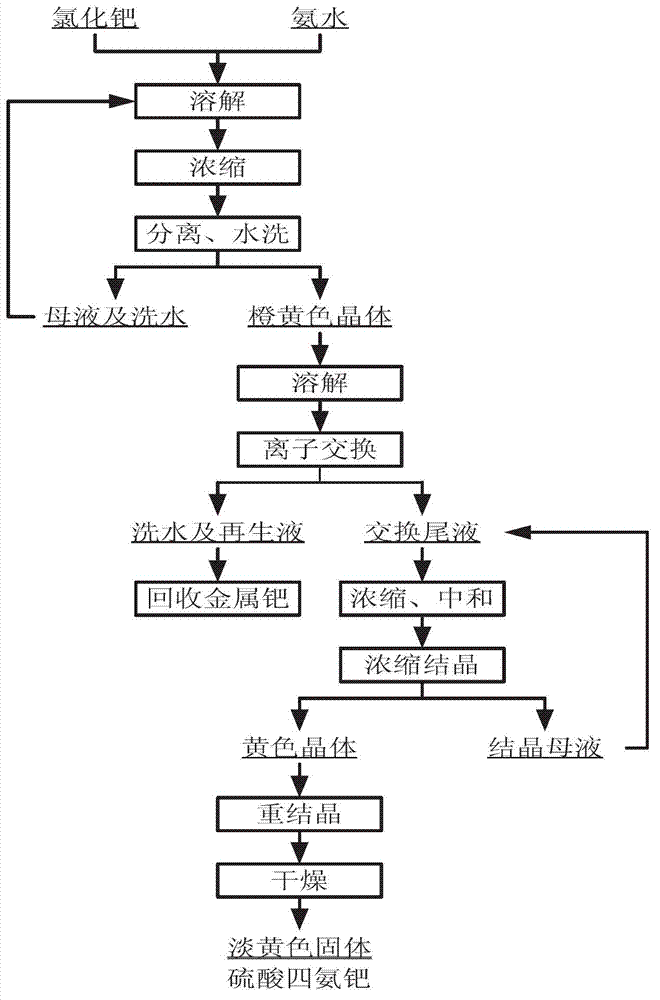Synthetic method of palladium tetra-ammino sulfate
A tetraammonium palladium sulfate and synthesis method technology, applied in chemical instruments and methods, ruthenium/rhodium/palladium/osmium/iridium/platinum compounds, inorganic chemistry, etc., can solve the difficult control of product yield and quality, and the increase of by-products , long technological process and other issues, to achieve high product yield, less side reactions, and good selectivity
- Summary
- Abstract
- Description
- Claims
- Application Information
AI Technical Summary
Problems solved by technology
Method used
Image
Examples
example 1
[0024] Take 200 g of reagent palladium chloride in a flask, add 600 mL of reagent grade ammonia water, heat in a water bath, keep the temperature constant at 50°C, stir for 30 minutes, all the solids are dissolved, and a light yellow transparent solution is obtained. Adjust the temperature to 85°C and keep the temperature for 3 hours, a large amount of solids precipitated out in the flask. The solid was separated by filtration, washed with pure water, the filtrate and washing water were collected for treatment, the solid was transferred to an oven, the temperature was controlled at 100°C, and the temperature was kept constant for 2 hours to obtain an orange-yellow solid.
[0025] The solid was dissolved in water, and the concentration of palladium in the adjusted solution was 5 g / L. The ion exchange resin tube has a volume of 10L and is filled with about 7L of 201×7 anion exchange resin. The prepared solution flows through the resin slowly at a flow rate of 50mL / min. During th...
example 2
[0033] Take 200 g of reagent palladium chloride in a flask, add 500 mL of reagent grade ammonia water, heat in a water bath, keep the temperature constant at 50 ° C, stir for 30 minutes, all the solids are dissolved, and a light yellow transparent solution is obtained. Adjust the temperature to 85°C and keep the temperature for 3 hours, a large amount of solids precipitated out in the flask. The solid was separated by suction filtration, washed with a small amount of water, the filtrate and washing water were collected for treatment, the solid was transferred to an oven, the temperature was controlled at 100°C, and the temperature was kept constant for 2 hours to obtain an orange-yellow solid.
[0034] The solid was dissolved in water, and the concentration of palladium in the solution was adjusted to be 10 g / L. The volume of the ion exchange resin tube is 10L, and it is filled with about 7L of 201×7 anion exchange resin. The prepared solution flows through the resin slowly at...
example 3
[0042] Take 1000g of reagent palladium chloride in a flask, add 2000mL of reagent grade ammonia water, heat in a water bath, keep the temperature constant at 60°C, stir for 30 minutes, all the solids are dissolved, and a light yellow transparent solution is obtained. Adjust the temperature to 85°C and keep the temperature for 5 hours, a large amount of solids precipitated out in the flask. The solid was separated by suction filtration, washed with water, the filtrate and washing water were collected for treatment, the solid was transferred to an oven, the temperature was controlled at 100°C, and the temperature was kept constant for 4 hours to obtain an orange-yellow solid.
[0043] The solid is dissolved in water, and the concentration of palladium in the solution is adjusted to be about 20 g / L. The volume of the ion exchange resin tube is 10L, and it is filled with about 7L of 201×7 anion exchange resin. The prepared solution flows through the resin slowly at a flow rate of ...
PUM
 Login to View More
Login to View More Abstract
Description
Claims
Application Information
 Login to View More
Login to View More - R&D
- Intellectual Property
- Life Sciences
- Materials
- Tech Scout
- Unparalleled Data Quality
- Higher Quality Content
- 60% Fewer Hallucinations
Browse by: Latest US Patents, China's latest patents, Technical Efficacy Thesaurus, Application Domain, Technology Topic, Popular Technical Reports.
© 2025 PatSnap. All rights reserved.Legal|Privacy policy|Modern Slavery Act Transparency Statement|Sitemap|About US| Contact US: help@patsnap.com

